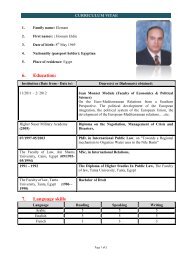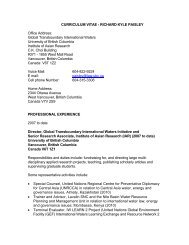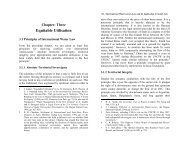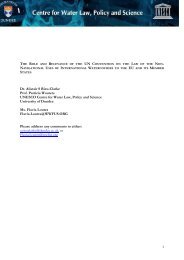Upreti, Trilochan, International Watercourses Law and Its Application ...
Upreti, Trilochan, International Watercourses Law and Its Application ...
Upreti, Trilochan, International Watercourses Law and Its Application ...
You also want an ePaper? Increase the reach of your titles
YUMPU automatically turns print PDFs into web optimized ePapers that Google loves.
96 / <strong>International</strong> <strong>Watercourses</strong> <strong>Law</strong> <strong>and</strong> <strong>Its</strong> <strong>Application</strong> in South Asia Development <strong>and</strong> Codification of <strong>International</strong> <strong>Watercourses</strong> <strong>Law</strong> / 97outlines state rights <strong>and</strong> duties in waters that extend from twoor more states territories. Article III provides:“if the various States disagree upon the extent oftheir rights of use, the disagreement shall be settledon the basis of equity, taking into consideration therespective needs of States, as well as any othercircumstances relevant to any particular case” 213 .Article IV states that any act of a state harmful to another stateentitles the latter to receive adequate compensation for any lossor damage incurred. Article V indicates the need to have priornotice <strong>and</strong> consultation before initiating any work onwaterways or watersheds. Such rules also stipulate thatnegotiations should be conducted in good faith in the event ofsuch works giving rise to conflict.2.9.5 Some Other InstitutionsThe codification <strong>and</strong> development of international law are theaccumulation of institutional contributions. As far as IWL isconcerned, the contribution of the ILI, ILA <strong>and</strong> ILC aresignificant. There are a few other institutions that have alsomade contributions in the area. The Asian-African LegalConsultative Committee (AALCC), which has a workingrelationship with the ILC, has adopted a Draft Proposition onthe <strong>Law</strong> of <strong>International</strong> Rivers in 1973 at its New Delhiconference. Article III envisaged:"1. Each basin state is entitled, within its territory,to reasonable <strong>and</strong> equitable shares in the beneficialuse of the waters of an international drainage basin.2.What is a reasonable <strong>and</strong> equitable share is to bedetermined in the interested basin state by213 Ibid. p. 280.considering all the relevant factors in eachparticular case.” 214It is an obvious endorsement of the Helsinki rules. The Inter-American Bar Association in its Tenth conference onNovember 19, 1957 in Buenos Aires initiated work onformulating the principles on international drainage basins <strong>and</strong>adopted five principles. In its San Jose Resolution in 1967, No1, third paragraph, states:"<strong>International</strong> waters have for America uniqueimportance to the extent that it is difficult toimagine a social <strong>and</strong> economic development <strong>and</strong>integration of the continent without an equitable<strong>and</strong> adequate usage of such waters, in achievingwhich the law has a substantial function" 215Besides this, there are several other organizations, which havealso contributed to the development <strong>and</strong> codification of thetopic. UNEP Principles on Conservation <strong>and</strong> HarmoniousUtilization of Natural Resources Shared by Two or More States1978 is also pertinent in this area. 216 The UNGA Resolution3129 (XXVIIII) 1973, called for adequate internationalst<strong>and</strong>ards to be established, for the conservation <strong>and</strong> utilisationof natural resources common to two or more states, <strong>and</strong> the cooperationamong those states to be enhanced by the exchangeof information <strong>and</strong> prior consultation. The principle was notendorsed by the UNGA as a general principle of law but itsimply acknowledged it. The principle forms a part of soft law.Apart from this, the Economic Commission for Europe (ECE)has adopted a regional Convention on the Protection <strong>and</strong> Use of214 AALCC, Report of the Fourteenth Session held in New Delhi, 10-18January (1973), pp. 7-14; also see supra note 57, p. 202. In ArticleIII(3) eleven factors are recommended.215 Supra note 57, pp 317-320.216 Supra note 66, pp 21-26.












